WORKING OUT COMBAT SEQUENCES FROM SPECIALIZED SETS
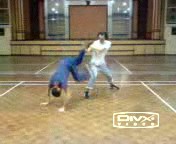
Why did kungfu masters in the past fight the way they fought?
Many martial artists think that kungfu patterns are too elaborated, and in real fighting one merely punches and kicks. About thirty years ago some innovative kungfu masters, dismayed at the inability of most kungfu practitioners to spar but unaware of traditional kungfu combat methodology, borrowed fighting methods and sparring methodology from Karate and Taekwondo which were popular at that time. Bruce Lee was the most celebrated example.
Some of these masters added the term “Do” (which is the Japanese and Korean term for the Chinese “Tao” meaning “the Way”) to the arts they invented or modified, such as “Jeet Kwon Do”, “Shaolin-Do” and “Nan Quan-Do”. These masters deserve our respect, although we may not agree with their methodology. They felt strongly enough about the pathetic condition of kungfu to make changes, and were brave in their innovations.
Their kungfu underwent a process of simplification. They did away with “elaborated” patterns like “tiger-claws”, “dragon-hands” and “unicorn-steps”, and reduced “flowery” movements to straightforward punches, kicks and blocks. As a result their kungfu became karate-like, and in the case of Jeet Kwon Do, taekwondo-like — to a point where it became debatable whether they can still be called kungfu. On a personal note, I remember my sifu, Sifu Ho Fatt Nam, was much saddened by this development, and we had long discussions over this issue, from which I benefited much.
But how did kungfu masters in the past spar and fight? Did they practice free sparring?
Of course they sparred. Without sparring they would not be able to fight, no matter for how they practiced their solo kungfu sets. But having undergone appropriate combat application training, performing kungfu sets was an effective way to enhance their fighting. And kungfu masters in the past fought extremely well. They fought using typical kungfu skills and patterns, like what is shown in kungfu movies although real life fight was not so elegant to watch and might end very fast.
How could we be sure that kungfu masters in the past used kungfu patterns in their fighting? It is only logical. Unlike at present, in the past kungfu was practiced not for show but for fighting. If any patterns were not useful for fighting, they would have been eliminated and not passed down to us. More objectively, the way kungfu masters sparred and fought was recorded in words and depicted in pictures still extant today. But most importantly, we know it from direct experience. Both in our own training and in actual fighting, we have found that using kungfu patterns, including stances, gives us great advantages in combat.
Why did kungfu masters in the past fight the way they fought? Here is a very brief historical explanation. Untrained persons fought like children, i.e. instinctively — punching wildly, grappling and wrestling each other and rolling on the ground. Soon frequent fighters discovered that it was more advantageous to strike than to grapple. Hence the earliest fighters fought like Boxers. Later they discovered that if they could balance themselves and kick well, kicking was more advantageous than striking. So they fought like Kick-Boxers.
Next, they discovered that they could catch the opponent's legs and throw him onto the ground. They then found various ways to pin him down. They also discovered ways to lock an opponent while he was standing. Master fighters discovered that by gripping special points and tendons, they could control their opponents. During these developmental processes they discovered that by adopting certain stances and using certain movements, they could execute their attacks and defences better. Over many centuries these advantageous stances and movements developed and stylized into kungfu patterns. The masters also developed effective methods of training.
We are very lucky that we still have the traditional kungfu sparring methodology used by kungfu practitioners in the past. Participants to the Special Shaolin Kungfu Course in September 2005 in Malaysia went through this kungfu sparring methodology — amazingly experiencing in a few days the gist of the sparring development that spanned many centuries! The video clips in this series show some of these lessons where the participants worked out combat sequences of their own from their specialized sets to meet specific combat situations, like fighting against Kick-Boxers or applying their special techniques. The videos were taken impromptu and are released here without any editing so that you can see the learning process including the mistakes some participants made.
Working Out Various Ways of Combat
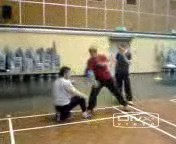
Participants from the Special Shaolin Kungfu Course of September 2005 work out various ways of combat based on certain themes. They choose their patterns from their specialized kungfu sets, which are “Tiger-Crane”, “Dragon Form”, “Dragon-Tiger”, “Five Animals” and “Monkey”.
Combat Sequences from Dragon Form
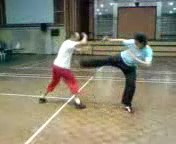
Hubert chooses patterns from his specialized set, “Dragon Form”, to compose combat sequences with certain themes. The sequences here are comprehensive, covering all the four categories of attacks, and they are developed from the 16 Basic Combat Sequences learnt at an earlier level. He then explains the reasons for his choice. Will you still be able to use these sequences if the opponent attacks in a different order. You will if you have learnt how to make adjustment taught in basic Combat Sequences.
Counters against Boxers and Muai Thai Fighters
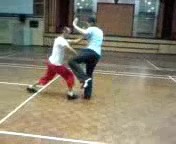
Hubert and Jonny, both specializing in the “Dragon Form Set”, work out combat sequences against Boxers and Muai Thai fighters. Could they defeat Boxers and Muai Tahi fighters with these patterns? That depends on the combat skills of their opponents, but it is certain that if someone practices these patterns correctly for a year, he will be in a better position in fighting Boxers and Muai Thai fighters than another person of a similar level free-sparring randomly for five years.
Dragon-Tiger Patterns against Kick Boxers
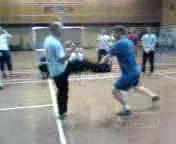
Simon, Chris and Mark work out two combat sequences against typical Kick Boxing attacks. The importance and advantages of stances are obvious here. Much of Mark's effectiveness in his counters against a Kick-Boxer's attacks lies in his agile body-work due to his good stance. What would happen if an attacker uses other techniques not from Kick-Boxing, such as from Judo throws or Aikido holds? Then we would use other appropriate combat sequences.
Dragon-Tiger Patterns against Holds and Throws
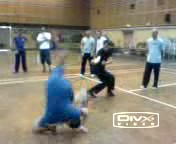
Here Simon, Chris and Mark work out patterns from their Dragon-Tiger Set against throws and holds, as well as upper cuts and side kicks. Are their movements too slow for real combat? This is a workout, not a real combat. They purposely slow down their movements both for themselves to check their forms and for others to see so as to comment. When the sequences have been studied, improved upon and accepted, the sequences can be performed fast and with flowing force.
Swimming Dragon and Taming Tiger
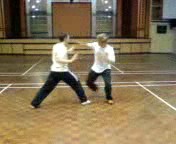
The patterns here worked out by Sifu Jordan and Henrick from the “Five-Animal Set” are more sophisticated than the straight-forward punches and kicks of Boxers and Kick-Boxers, and are used by kungfu exponents who use kungfu fighting. This represents the next stage of the development of fighting techniques. By using stances and body-work they can be faster than Boxers and Kick-Boxers who bounce about.
From Linear to Sideway Attacks
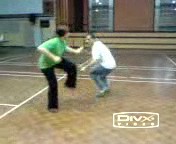
The patterns used by Nicky and Ronny and taken from their specialized set, “Dragon Form”, are also more sophisticated. The attacks have also moved from linear to sideways. This video clip answers some common doubts of people who think that kungfu patterns are too elaborated, that stances slow down a fighter's action, and that effective fighting consists of punches and kicks like those from Boxing and Kick-Boxing.
Swerving Dragon and Phoenix-Fist
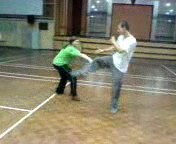
Nicky makes good use of the swerving movements of the Dragon to handle some sophisticated attacks by Ronny. Her counters are fast, without appearing fast, using the principles “no defence direct counter” and “starting later arriving earlier”. She also uses the phoenix-fist. The Phoenix is the female counter-part of the Dragon.
Tiger-Claw and Single Legged Crane
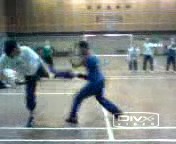
Innes and Davie, both from Shaolin Wahnam Scotland, demonstrate some simple yet profound patterns from their specialized set, “Tiger-Crane”. Many people may not realize that the first few patterns are Tiger-Claw attacks, which by themselves can put an opponent out of action if internal force is applied at the opponent's vital points. Innes executed a beautiful Tiger-Tail Kick, to which Davie responses effectively due to his good footwork.
The Hard and Soft of Tiger-Crane
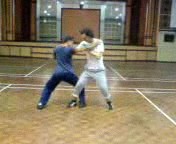
Davie and Innes demonstrate some beautiful and effective techniques from their specialized set, “Tiger-Crane”, which manifests both the “hard” and the “soft” aspects of kungfu. Notice how easily they counter Boxers' punches and Kick-Boxers' kicks. But if you use some of the Tiger-Crane techniques shown here to attack a Boxer or a Kick-Boxer, or an exponent of Karate, Taekwondo, Judo or Wrestling, he may not have any techniques in his art to counter your attack.
One Mile, Hundreds of Miles

What would you do if your opponent catches your kicking leg? One counter is the Tiger-Tail Kick. Innes and Davie then explains the philosophy behind the composition of their combat sequences. Amongst other benefits, understanding the relevant philosophy enables us to achieve maximum results with minimum effort. It also helps us to realize the principle of “yiet lei thong, pa lei meng” (Cantonese pronunciation) or “having traveled the first mile, you will be able to travel hundreds of miles”.
Being Fast without Appearing to be Fast
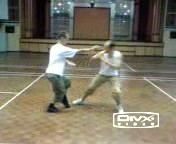
Sifu Markus of Shaolin Wahnam Finland uses patterns from “Dragon Form”, while Chris from Shaolin Wahnam Scotland uses patterns form “Monkey Set”. Sifu Markus is fast, without appearing to be fast, which is of course a high level achievement in kungfu. On the other hand, many movements appear to be fast, but are actually slow. Some examples are flashy high kicks and vigorous bouncing about.
False False, Real Real
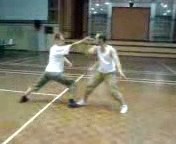
Techniques from the Monkey Set are tricky and deceptive. These two features may not be so obvious in this video clip because this is a workout where the movements are slowed down. An example of trickiness if found at the start of the video where Chris pretends to attack the top when he actually attacks below. This is poetically expressed in Chinese as “hui hui siat siat” (Cantonese pronumciation; in Mandarin pronunciation it becomes a tongue twister — "shi shi shi shi") or “false false real real”.
LINKS
Lessons from the Special Shaolin Kungfu Course of September 2005
- Part 1 - Initiating and Responding to Attacks
- Part 2 - Secrets in Counters against Boxer's Attacks
- Part 3 - Process of Composing a Kungfu Set
- Part 4 - Combat Sequences from Specialized Sets
- Part 5 - Refining Combat Sequences of Specialized Sets
- Part 6 - Making Variations to Meet Changing Combat Situations
- Part 7 - Bringing out the Beauty of Shaolin Kungfu in Combat
- Part 8 - From Pattern-Sets to Sequence-Sets
- Part 9 — Sparring at the Haphazard, Technique and Sequence Levels
- Part 10 — Improving Techniques and Flow in Free Sparring
- Part 11 — Free Sparring using Kungfu Skills and Techniques
- Part 12 — The Flowing Water Staff and its Application
